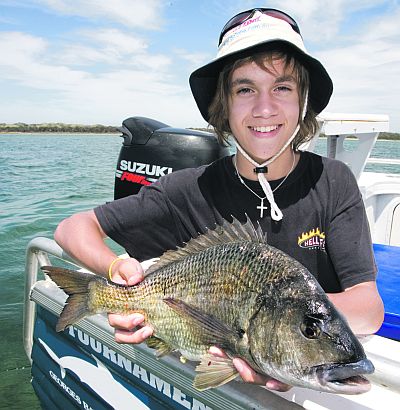 You can help bream research
You can help bream research
Dr James Haddy.
Do you want to be a recreational research angler? Have you ever wondered how old a bream is?. Been concerned about environmental flows into our estuaries or thought about how climate change might affect fish abundance. If so you might be able to help staff and students from the Australian Maritime College answer these questions by participating in a black bream research project as a recreation research angler.
How you can help
What we need is to obtain samples of ungutted bream frames from estuaries around the state to be donated for science. From these frames we can determine, the estuary it lived in, the sex and size of the fish and obtain samples of muscle tissue and earbones. These samples can then be used to generate information to help answer questions such as; Do bream move between estuaries? How fast bream grow in each estuary. What the age structure and mortality rate is for each estuary? Are bream safe to eat? Or can years of poor bream growth and recruitment be associated with environmental records.
The reason we want to answer these questions is that climate change is a major environmental issue, with forecasts indicating an increase in temperature and a change in the severity and frequency of storm events. The combined effect of warmer water and altered environmental flows into estuarine waterways has the potential to adversely affect the heath status and biodiversity of coastal systems. Therefore there is a need to understand how future environmental change will affect biological processes.
Unfortunately this area of research has received very little attention, due to the lack of long term biological data that can be used to associate historical environmental records with biological processes. This project aims to address the lack of suitable biological data by using black bream as a historical bio-monitoring species. But we need help in obtaining samples.
Black bream is one of the key recreational fish species of southern Australia and is a long lived slow growing species that spawns exclusively in the upper reaches of estuaries. During spawning they form dense aggregations that are targeted by both commercial and recreational fishermen. As a result of this intense fishing effort many bream stocks in commercially exploited waters on mainland Australian are in a state of decline with large trophy size fish becoming rare. However, Tasmanian estuaries are unique in that commercial fishing and hence gill netting is prohibited in our estuaries. This management strategies means that Tasmania is one of the last strongholds of trophy sized bream. As these large bream can be up to 30 years old, these fish were actually spawned in the spring of 1980 and locked up in their bones is a 30 yr biological record of what they experienced throughout life.
To unlock this record we need to obtain the earbones or “otoliths” and cut them in half with a specialized saw. Once the earbones are sectioned we can view annual bands in the section just like the growth rings of a tree. These growth rings occur because the fish experiences periods of fast growth, when water temperatures are warm and periods of slow growth when water temperatures are cold. Therefore over each summer to winter cycle a single band of dense bone is formed. Although counting the number of bands will determine the age of the fish, by measuring the distances between each band we can reconstruct specific annual growth rates for each year of the fishes life. This data is the information I am really interested in, as it can provide the long-term biological datasets required to investigate the effects of various environmental conditions with bream growth. In addition to investigating environmental effects on growth, black bream also show variable recruitment rates as a direct result of changing environmental factors such as rainfall, river flows, salinity, temperature and low dissolved oxygen levels within the spawning grounds. As a consequence age structure information from each estuary can also be used to develop environmental-recruitment models.
So if you want to help us investigate these questions next time you go bream fishing and keep a few for dinner, Please don’t throw your bream frames away. Because I want their earbones. What I ask is for you to bag up the frames into a plastic bag, place a label with the date and estuary you caught them in and place them in your freezer. If possible you can drop these fish off directly to me at the AMC or as the project develops it is intended to get a few participating fishing shops that you can use as a sample drop off depot. I will come around to collect the frames on a regular basis and inform the staff what the results are finding. So if you are interested in becoming a recreational research angler or a fishing shop willing to participate and promote the project the please contact me by phone on 6324 3828 or 0439 032 935 or email This email address is being protected from spambots. You need JavaScript enabled to view it.. I will look forward to hearing from you.
Dr James Haddy.
Dr James Haddy is a lecturer for the National Centre for Marine Conservation and Resource Sustainability at the Australian Maritime College in Launceston. Over the past 15 yrs he has actively researched a variety of aspects of the biology and physiology of black bream in both Tasmania and mainland Australia.



